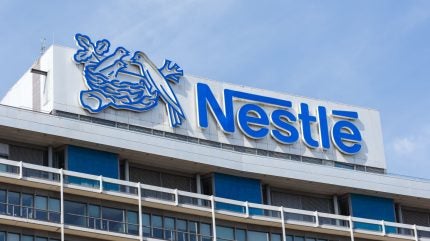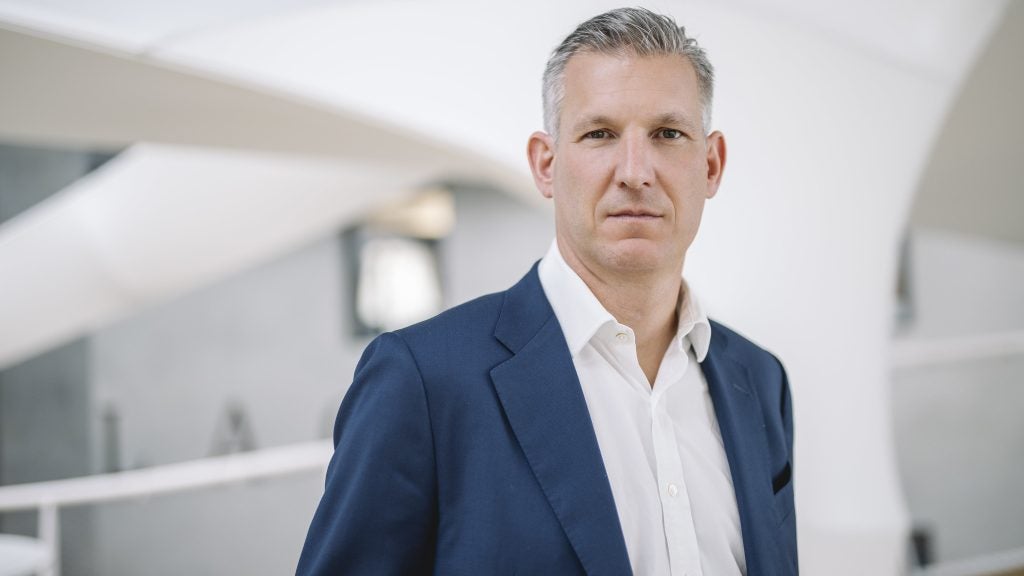
It all comes down to delivery for Nestlé CEO Philipp Navratil. Can he demonstrate concrete progress on his growth priorities by February next year?
After all, much of Navratil’s strategy outlined this week in his first presentation as CEO mirrored that of his predecessor Laurent Freixe, who departed under a cloud in September after just a year at the helm.

Discover B2B Marketing That Performs
Combine business intelligence and editorial excellence to reach engaged professionals across 36 leading media platforms.
What was perhaps different – and applauded by industry watchers – was Navratil’s language and gusto, which, along with a third-quarter rebound in the key real internal growth metric, were enough to drive the shares higher yesterday (16 October) as the new CEO set forth his agenda.
Effectively, the planned 16,000 global job losses over the next two years – 4,000 in production and the supply chain – were brushed aside but, on the flip-side, a boost to savings projections in the same timeframe were a positive.
Precarious might well be an apt description as such a huge number of job cuts perhaps demonstrate the challenges Nestlé, its industry peers and Navratil are up against right now. And, just as precariously, Nestlé’s shares headed lower in Zurich today.
Nestlé’s shares have lost more than 20% in the past five years. Think of the pandemic-related shutdowns and supply chain disruptions, consumer moves to health and GLP-1 weight-loss drugs, inflation and the cost-of-living crunch, US and reciprocal tariffs, and the well-voiced macro-economic environment.

US Tariffs are shifting - will you react or anticipate?
Don’t let policy changes catch you off guard. Stay proactive with real-time data and expert analysis.
By GlobalDataThere lie the external challenges for Navratil, who has only been in the job since the start of September – scant time to make your mark on the latest nine-month performance. Internally, Nestlé has lost market share to its peers, an aspect Navratil and his predecessor Freixe pledged to address.
“The world is changing and Nestlé needs to change faster,” Navratil said in his remarks to accompany the results. “This will include making hard but necessary decisions to reduce headcount over the next two years.
“We are fostering a culture that embraces a performance mindset that does not accept losing market share and where winning is rewarded.”
Potential trimming?
Like many big CPG manufacturers, Nestlé being the world’s largest, they have built up huge portfolios that have arguably bloated resources and some, characterised as legacy brands, have dropped out of favour as consumers evolve.
And much of the innovation has been sideways or bolt-on rather than ground-breaking new stuff. M&A has tended to resolve that.
However, no mention of asset disposals or portfolio trimming were mentioned by Navratil, at least not in his presentation, and neither were potential acquisitions.
Whether any of those options will surface from the CEO before the February full-year results announcement remain to be seen or any other surprises like yesterday’s news of hefty job cuts, mostly 12,000 white-collar workers.
“As Nestlé moves forward, we will be rigorous in our approach to resource allocation, prioritising the opportunities and businesses with the highest potential returns,” may be one hint put forward by Navratil.
An update on the review and potential disposal of the vitamins, minerals and supplements (VMS) revealed by Freixe in July has also not been forthcoming.
Nestlé’s “big bets”
However, the “six big bets” strategy introduced by Freixe at Nestlé’s capital markets day last November remains in Navratil’s tool kit.
“[Within] the framework of achieving efficiency to generate the fuel for growth, we can invest in our key brands and in our key growth platforms. This drives category growth and market-share gains, leading to sustainable and profitable growth, which in turn brings the benefits of scale and value creation,” Freixe outlined at the time.
Those bets lie outside of Nestlé’s so-called billionaire categories that each have the “potential to achieve at least” SFr100m ($126.1m) in “incremental” sales annually, starting in 2025 and running through 2027, he said.
Speaking at a Barclays’ investor event in September, CFO Anna Manz said: “We have closed the share-loss drag associated by those underperformers by more than a third in the last six months,” adding that there had been “good momentum” in the first half with SFr200m reached “collectively”.
Fast-forward to this week and Nestlé said it will have “increased ambition on innovation, building on the momentum of the six global big bets and broadening our approach, including a step change in consumer insights and marketing capabilities”.

Marketing breadth
Details on marketing investment was absent from Navratil’s remarks, a facet some analysts singled out as a key requisite to help drive growth.
RBC Capital Markets’ analyst James Edwardes Jones wrote: “Beyond this year, we do not know the magnitude of marketing investment yet.
“However, we do expect this to step up as Nestlé incrementally invests to back its big bets and forecast a slightly more gradual improvement in trading operating profit margin towards 17% mid-term.”
The mid-term guidance for the underlying trading operating profit (UTOP) margin – a closely watched metric along with real internal growth – was left unchanged by the new CEO this week. It remains “at or above 16%”.
RBC forecasts 16% for this year, rising to 16.3% and 16.8% over the following two years.
Meanwhile, the Barclays’ team led by Warren Ackermann said they “suspect that marketing spend will be a key feature of Nestlé’s fuller strategy update” in February at the year-end stage.
“A good debut from Nestlé and the new CEO,” the Barclays analysts said. “The new savings are the highlight and hard cost savings are welcome but we would still like to see it funding higher marketing spend,” they added, referring to the step up in cost savings revealed yesterday to SFr3bn by the end of 2027 from a previous projection of SFr2.5bn.
RIG focus
Real internal growth (RIG) – a measure that strips out the effect from pricing on the organic numbers – has been a contentious issue for Nestlé, Freixe and his predecessor Mark Schneider for some time. And RIG was also front and centre of Navratil’s strategy plan.
“Overall, we would give this a 8.5/10 and think there is enough for investors to start to think that this could be a real line in the sand, after five years of underperformance,” the Barclays’ team concluded.
RIG rebounded to 1.5% in the third quarter from a negative 0.4% in the prior three months, giving an average for the year to date of 0.6%. That figure would suggest full-year RIG may beat, or at least match, the 2024 print of 0.8%.
Nevertheless, while it would represent an extended improvement from minus 0.3% in 2023 and just 0.1% in 2022, RIG would still be well below historical rates. It was at 5.5% in 2021, for instance.
“Driving RIG-led growth is our number one priority,” Navratil said. “We have been stepping up investment to achieve this, and the results are starting to come through. Now we must do more and move faster to accelerate our growth momentum.”
That momentum has also been lagging in the organic growth numbers, which hit 3.3% in the first nine months, on target to beat last year’s 2.2%. However, it was as high as 7.2% in 2023 and 8.3% the previous year.
“We welcome Nestlé making RIG-led growth its key priority, while solid Q3 trading also shows good progress of its growth rehabilitation strategy,” Jones at RBC wrote.
“However, it is still too early to call this a success and the company still needs to execute on its ambitious plans. Hence, we still rate its shares sector perform, albeit at higher price target of SFr82.00.” RBC’s previous target was SFr80.00.
Bernstein analysts, led by Callum Elliott, suggested the RIG improvement, “combined with the unexpected strategic update…is likely to fuel the narrative that Nestlé is turning a corner”.
Innovation challenge
Navratil also plans to put more weight behind innovation to address share-losses but that was also part of Freixe’s agenda, too. But again it was the language used by the CEO that emboldened investors.
“Rigorously prioritising growth opportunities,” was how Navratil phrased it, adding: “We will be bolder in investing at scale and driving innovation to deliver accelerated growth and value creation.”
By contrast, Freixe said at last November’s capital markets day: “We will increase our investment to support organic growth at the same time as we will raise our game in terms of quality of execution.
“I have been very clear about the need to increase our investment to support growth, to support our brands.”
Picking up on Navratil’s tone, Jones and the RBC team wrote: “We also welcome Navratil’s ambition to foster a culture that does not accept losing market share and where winning is rewarded, which sounds more assertive than before.”
Navratil’s mettle will now be tested to see if he can deliver on the aspirations outlined this week and whether he can make good on his promise to shareholders.
“The actions we are taking will secure Nestlé’s future as a leader in our industry. Collectively, they will enable us to improve our overall performance and deliver shareholder value,” he said.
Hurdles remain, however. As Nestlé heads into the busy Christmas quarter, Navratil suggested the final three months of the fiscal year will be met with a challenging comparison base.
With February still four months away and 20-year Nestlé veteran Navratil still warming up the CEO seat, could we expect more surprises?
“Under the new CEO, the tone has shifted toward driving agility and transparency,” the Jefferies analysts wrote. “Further operational reviews look likely, and the visibility on the headcount reductions that contribute to gross cost saves is a major boost to their credibility.”





